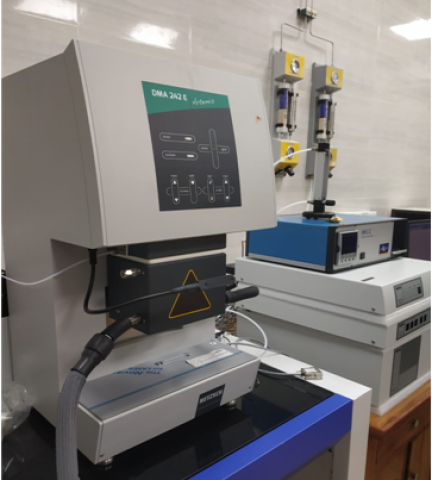
External users: registration to be carried out only through I-STEM portal
Additional information about sample and analysis details should be filled in the pdf form provided in the I-STEM portal under “DOWNLOAD CSRF”
Internal users (IITB): registration to be carried out only through DRONA portal
Additional information about sample and analysis details should be filled in the pdf form provided here.
.
Category
- Material Characterization » Mechanical Characterisation
Booking Details
Temperature Range:-170 to 600°C
Heating Rates:0.01 to 20°C
Frequency range:0.01 to 100 Hz
High Force Range:24N (12N static and 12N dynamic)
Amplitude range:±0.1 upto 240 µm
Static deformation:20 mm
Maximum Deformation amplitude:+240 µm
Available Geometries:Three-point bending (40 mm)
Single and Dual Cantilever (2 x 16 mm)
Compression/ penetration (Ø 15 mm)
Tension (15 mm)
Atmosphere: Nitrogen and Air
Cooling Devices:Liquid Nitrogen and Air Intra Cooler
Facility Management Team and Location
nmagadi@iitb.ac.in
022- 2159-6851
Facility Features, Working Principle and Specifications
Facility Description
Deformation modes
- 3-point bending
- Single / dual cantilever bending ·
- Shearing ·
- Tension ·
- Compression/penetration
Force Range with high force of 24N (12N static and 12N Dynamic)
Temperature -170°C to 600°C
Dynamic Mechanical Analyzer (DMA) measures the mechanical properties of a material as a function of time, temperature, and frequency under an oscillatory load. The DMA works by applying an oscillatory force to the sample at a specific frequency and measuring the resulting deformation. The amplitude and phase of the applied force and the resulting deformation are recorded, allowing for the calculation of various mechanical properties.
By varying the frequency, temperature, and applied stress or strain, the DMA can provide information about the material's viscoelastic properties. Viscoelastic properties refer to their ability to exhibit both elastic and viscous responses when subjected to deformation. The instrument can measure properties like storage modulus (elastic response), loss modulus (viscous response), glass transition temperature, and other mechanical properties.
Sample Preparation, User Instructions and Precautionary Measures
Sample size should be uniform and dimensions should be as per the deformation mode selected.
| Mode | Length/diameter | Width | Thickness/Height |
1. | Tension | 18-20 mm | 4-6 mm | < 6 mm |
2. | Single Cantilever Bending | 30-40 mm | < 12 mm | < 5 mm |
3. | Double Cantilever Bending | 55-60 mm | < 12 mm | < 5 mm |
4. | 3-point bending | 55-60 mm | < 12 mm | < 8 mm |
5. | Shear mode with flat surface | 15 mm | 15 mm | < 6 mm |
6. | Compression and penetration | 15 mm | --- | < 8 mm |
Charges including 18% GST:
|
Charges for Analytical Services in Different Categories
Applications
Viscoelastic properties such as:
- Storage modulus: E', G' (purely elastic component).
- Loss modulus: E", G" (purely viscous component).
- Loss tangent: tan δ (E"/E’), and their dependence on temperature/ frequency.
Damping characteristics and viscoelastic behaviour.
Polymer structure and morphology.
Glass transition temperature Tg.
Primary & secondary relaxation behaviour.
Crystallization processes.
Influence of fillers in polymers, etc
Sample Details
NA
NA
NA
NA
NA
NA
NA
SOP, Lab Policies and Other Details
Publications
NA
